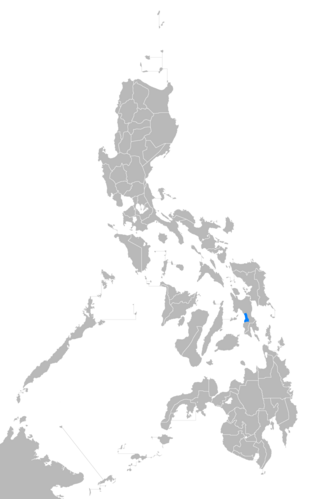| Baybay | |
|---|---|
| Utudnon | |
| Baybayanon | |
| Native to | Philippines |
| Region | Baybay, Leyte |
Native speakers | 10,000 (2009)[1] |
Austronesian
| |
| Language codes | |
| ISO 639-3 | bvy |
| Glottolog | bayb1234 |
 Areas where the Baybay language is spoken. | |
The Baybay language, also known as Baybayanon, Utudnon, Waya-Waya or Leyte, is a distinct regional language that was spoken on the island of Leyte in the Philippines before the arrival of Waray and then later, Boholano and Cebuano. It is still spoken around the city of Baybay. It is part of the Bisayan language family and is closely related to other Philippine languages.
Classification[edit]
Baybayanon was originally a Warayan language that has been relexified and overlaid by a Cebuano (Leyteño) superstratum.[2] The Warayan substratum is characterized by Baybayanon's more Waray-like deictics, and various other features.[2]
Geographic distribution[edit]
Utudnon is spoken by about 10,000 people in five barangays of Baybay municipality,[3] central Leyte, namely Utúd (also called Utod or Guadalupe), Gábas, Kilím, Pátag, Pangasúgan and Hibunawan.[2]
References[edit]
- ^ Baybay at Ethnologue (18th ed., 2015) (subscription required)
- ^ a b c Rubino, Carl (2005). "Utudnon, an Undescribed Language of Leyte" (PDF). In Liao, Hsiu-chuan; Rubino, Carl R. (eds.). Current Issues in Philippine Linguistics and Anthropology: Parangal kay Lawrence A. Reid. Manila, Philippines: Linguistic Society of the Philippines and SIL Philippines. pp. 306–336.
- ^ ISO 639-3 Registration Authority (2009). "Request for New Language Code Element in ISO 639-3" (PDF). request number 2009-083.
{{cite web}}: CS1 maint: numeric names: authors list (link)
| Asi | |||||||
|---|---|---|---|---|---|---|---|
| Cebuan | |||||||
| Central |
| ||||||
| West |
| ||||||
| South |
| ||||||
| (unclassified) | |||||||
See also: Visayan peoples | |||||||
| Batanic (Bashiic) | |||||||||||||||||||||||||
|---|---|---|---|---|---|---|---|---|---|---|---|---|---|---|---|---|---|---|---|---|---|---|---|---|---|
| Northern Luzon |
| ||||||||||||||||||||||||
| Central Luzon |
| ||||||||||||||||||||||||
| Northern Mindoro | |||||||||||||||||||||||||
| Greater Central Philippine |
| ||||||||||||||||||||||||
| Kalamian | |||||||||||||||||||||||||
| Bilic | |||||||||||||||||||||||||
| Sangiric | |||||||||||||||||||||||||
| Minahasan | |||||||||||||||||||||||||
| Other branches |
| ||||||||||||||||||||||||
| Reconstructed | |||||||||||||||||||||||||
| |||||||||||||||||||||||||
| Official languages | |||||||||||||||||||||||||||||||||||
|---|---|---|---|---|---|---|---|---|---|---|---|---|---|---|---|---|---|---|---|---|---|---|---|---|---|---|---|---|---|---|---|---|---|---|---|
| Regional languages | |||||||||||||||||||||||||||||||||||
| Indigenous languages (by region) |
| ||||||||||||||||||||||||||||||||||
| Immigrant languages | |||||||||||||||||||||||||||||||||||
| Sign languages | |||||||||||||||||||||||||||||||||||
| Historical languages | |||||||||||||||||||||||||||||||||||
Well, that’s interesting to know that Psilotum nudum are known as whisk ferns. Psilotum nudum is the commoner species of the two. While the P. flaccidum is a rare species and is found in the tropical islands. Both the species are usually epiphytic in habit and grow upon tree ferns. These species may also be terrestrial and grow in humus or in the crevices of the rocks.
View the detailed Guide of Psilotum nudum: Detailed Study Of Psilotum Nudum (Whisk Fern), Classification, Anatomy, Reproduction